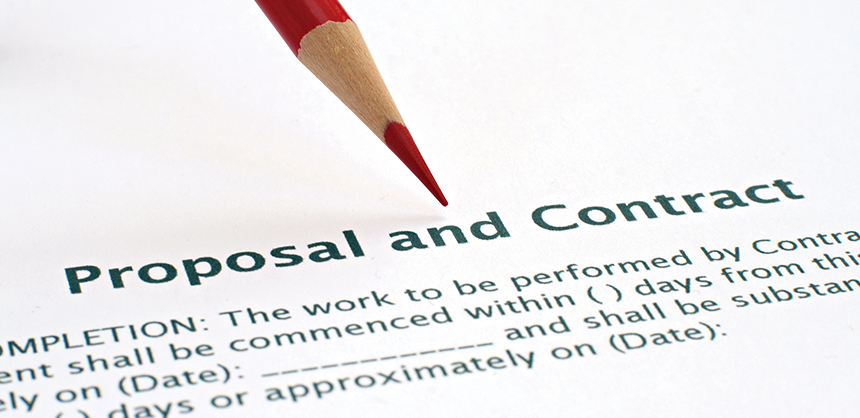Build a Better RFPMay 20, 2021
Every Great Event Starts at the Beginning With a Detailed RFP By Nancy MuellerBuild a Better RFP
Every Great Event Starts at the Beginning With a Detailed RFP
DepositPhotos.com
Last year was a game changer for the meetings and events industry as planners had to learn how best to adapt to an ever-evolving landscape during the COVID-19 pandemic. Yet, along with crisis comes the opportunity to solidify vital partner relationships, such as those between planners and potential suppliers. And one of most effective business tools for nurturing and developing partner relationships in the meetings industry is the Request for Proposal document.
Why Write an RFP?
Even when meeting planners have an established supplier relationship, the need for an RFP that protects both parties in the case of unforeseen circumstances has never been more important, as evidenced by how quickly things changed last year. And if there’s one trend that stands out in the past year’s RFP process, it’s the need to “get through proposals quickly,” says Ceré Netters, CMP, director of events at WorldatWork, which is tied to the supply and demand of services and spacing due to COVID-19.
Pamela Gilbert, director of sales and marketing for Fairmont Hotels & Resorts, agrees. In her position as hotel supplier, she has experienced “shortened booking windows, with tremendous urgency for responses.” Gilbert also cites other trends, such as “smaller sizes of meetings for the next 12 months, increased numbers of groups requesting hybrid meetings — 50-250 people in-person, with a large number of virtual participants — and large groups shifting to meeting in waves of smaller number of attendees back-to-back; that is, changing a 750-person meeting to three waves of 250 people each.”
In addition, Necoya L. Tyson, CCEP, CEM-AP, CGMP, vice president of banker education & events with the Texas Bankers Association, says the biggest trend she’s seeing is that RFPs now have much more information on pandemic planning. Planners want to know “What processes and procedures are these vendors putting in place due to COVID-19?” What’s clear is that the RFP is not a static document, but rather one that remains responsive to current meeting needs and expectations.
What hasn’t changed in building a better RFP, explains Pawntra Shadab, CIS, CTA, CITP, vice president & event strategist at Elite Productions International, is the overall purpose of the document: “Writing an RFP helps set the tone and aids in creating transparency so both parties are aware of expectations.”
Netters thinks it’s more important than ever that RFPs are very clear and detailed. “Whether your RFP is for a solutions provider or venue, it’s important for the receiver to know exactly what you are looking for and the needs that you have.” Plus, as Tyson points out: “It’s important to write an RFP so that all the details of your event, your event’s wants/needs and historical information about your event are listed in detail in one location.”
While “not imperative,” from Gilbert’s perspective as hotel supplier, she finds the RFP process “very helpful for both the planner and supplier” because in her view, “A written request for proposal is an effective and efficient means of defining your requirements for your program, and assuring that key requirements are understood quickly,” she says. “Ideally, a written RFP begins the process, and allows planners and hotel representatives to identify match potential rapidly, and saves time for both. This allows a planner to narrow down suppliers with less direct communication required until a match is identified.”

DepositPhotos.com
The Ideal RFP
Clear. Comprehensive. Long on details. These three elements set the foundation for an effective RFP, according to Shadab, Netters and Tyson. For Shadab, that means “a comprehensive overview of the company, what problems need to be solved, what’s worked and hasn’t worked, as well as the project goals.” Specific examples include “a timeline, principal point of contact, budget and objectives.”
Netters says a good RFP must have explicit details of the event. She recommends planners “go through the ‘W’s’ and the ‘H:’ when, where, why, what and how many.” Tyson adds, “Projected attendance and number of exhibiting companies,” as well as “amount of space that’s projected to be used in square footage and number of meeting rooms,” are also critical RFP components.
From the supply partner’s perspective, Gilbert thinks RFP “must-haves” also include a “day-by-day room block and program agenda,” in addition to the “days and dates of the program, state location of the planner, and industry type, such as banking or pharmaceutical.” She adds that an ideal RFP also “adds the set-up style specifications for the meeting space, suite requirements, and special services required.” For example, she says they “must provide round-trip airport transportation, or must have licensed nurse on-site —anything that is a special ‘must-have’ for the group.” So, too, it’s imperative to know of any budget restrictions or requirements, “particularly if there are association bylaws regarding rates or spending,” Gilbert says.
As far as “nice-to-haves,” which can be described as the pieces that elevate the experience but aren’t critical to have for the event, Tyson suggests, “any comps, whether it be room nights, if it’s a hotel RFP, or signage/exhibit hall comps, if it’s a general service contractor RFP” should be discussed before conversing with the supplier “to enable better initial proposals.”
Gilbert outlines such nice-to-haves as “profile of attendees, program objective, history of hotel room block pick-up and F&B [or list of hotels who have hosted planner programs in the past], past challenges or concerns you have had in hosting and wish to avoid, and best experiences you have had at past hotels that you want to duplicate.” One new item that Gilbert singles out for inclusion among the other nice-to-haves is “group risk tolerance and any company required protocols related to meetings or travel.” She advises planners to “make sure to share their needs and expectations with the hotel.” The more partners can clearly communicate their needs and expectations upfront, the better for everyone concerned.

DepositPhotos.com
Do’s and Don’ts of Submitting RFPs
In conversations with both planners and site suppliers, partners emphasize the need to respect each other’s time in the RFP process. Tyson advises clients that the RFP is necessary for some organizations and that “can take time.” She explains: “We can’t just choose any vendor without going through the process of sending out an RFP and evaluating all bids received so that the process is fair. More often than not, I may be sending an RFP to at least five to six different hotels or companies in order to do our comparisons and then get some internal feedback or buy-in.”
One means to expedite the RFP process, offers Netters, is for planners to question themselves about the organization’s needs from the start. “While understanding that we need more space due to social distancing protocols,” for example, “do we really need that many rooms? Do we really need that much load in or load time?” As she explains: “Keep in mind that this industry is at a critical turning point, and we’re all trying to survive and recover, and hotels and venues need to make money, too. Do ask questions that are critical to your event and/or attendees, but be open to feedback and alternative options.”
Gilbert notes that “the more transparent a planner is with their initial proposal about their needs and what’s important to them, the more complete the initial bid will be to help both parties determine the level of time to invest in the bid process with each other.” For instance, a deal-breaker “critical to their leadership” for one of Gilbert’s prospective planners meant confirming that the hotel would be able to deliver morning room service to each guest room at a specific time. “This enabled the sales manager to involve operations early to verify it could happen, so that we could provide a detailed proposal on how we could accomplish it with costs for the service in the initial bid,” Gilbert says.
For Netters and Tyson, RFPs not only serve for hotel and city location comparisons, but also when considering general service contractors, such as technology solution and A/V providers. Tyson recommends that planners “send your RFP to a diverse set of vendors [diverse in size, number of years in business, experience],” adding, “I always suggest getting at least three bids.”
In her position within “a full-service meetings and events agency,” Shadab offers this view: “We have received RFPs from clients to come in as a planner and supplier, and also have submitted RFPs to our vendors and partners for elements that we need to outsource. It’s a team effort.” As such, “Being respectful of people’s time is important,” Shadab says. “If you already have a partner,” for instance, “don’t ask others to submit a proposal unless you are seriously considering them.”
Gilbert concurs, adding that it would reduce time, and the costs to hotels and other venues, if planners could narrow down the locations and preferred third parties to those they’re actually considering. “Choose one third-party vendor on Cvent,” Gilbert says. “Don’t duplicate. Otherwise, the hotel will have to choose which third party through which to submit their bid as the hotel will not commission multiple third parties. For example, if you want to work with ALHI, don’t also reference ConferenceDirect in the RFP. At hotel supplier industry conferences, this is the No. 1 complaint I have heard about the RFP process through planners using Cvent.” Do the same with locations, she adds, “If you know you are looking at Austin, Scottsdale and San Diego, don’t distribute the RFP to every warm weather destination in the country. A hotel manager/sales director/group revenue manager spends an average of three to four hours loading an RFP into the sales system, completing a daily business review form, determining the best space to propose and blocking that space in the system.”
Plus, Gilbert explains, if there are any special criteria, it takes additional time for the hotel supplier to reach out to internal operating stakeholders needed to make decisions. “To make it easy and efficient for both the planner and on-site destination, please don’t waste a sales manager’s time doing this work if you know it is very unlikely that you will consider the destination.”
Netters suggests another way planners and suppliers can save time in the RFP process. “Sometimes after an RFP comes back, we’ll immediately get multiple follow up calls within minutes.” So to expedite the communications between planners and suppliers, Netters adds, “For me, personally, I prefer one email with the proposal and with text that states they will follow up on a certain date if they have not heard back.”
Once planners have made their supplier decision, be sure to notify the other destinations who had been under consideration. Not only is doing so a professional courtesy, but as Gilbert explains: “When a sales manager follows up without response multiple times, without any feedback for leads, it slows hotels’ negotiations with other accounts and creates unnecessary work load.” She asks planners to “please take a minute to call or send a note to let the hotels know they are no longer being considered.”
RFP Reminders
Confirm and verify is still the name of the game in event planning. “Always double-check your dates and timeline,” Netters suggests. Gilbert cautions suppliers not to “fill in the blanks for a planner.” That means “don’t assume you know what they meant if they are unclear. For example, if they send you dates without mentioning the days of the week, verify the days of the week in your proposal. One of the most frequent errors on RFPs is with planners submitting RFP listing dates, only to find that they were off on the day-of-the-week pattern they required.” Remember, too, advises Netters, “Because RFPs can feel a little cookie cutter, it’s important to ensure you’re tailoring your RFP exactly to the company or venue you’re sending it to.”
The bottom line? Take the time to send a perfect RFP. “The process of sending an RFP can be time-consuming and tedious,” Tyson says. “But it’s totally worth it in order to see our options laid out.” | AC&F |










